
Hażlach is a village and the seat of Gmina Hażlach in Cieszyn County in Silesian Voivodeship, southern Poland.
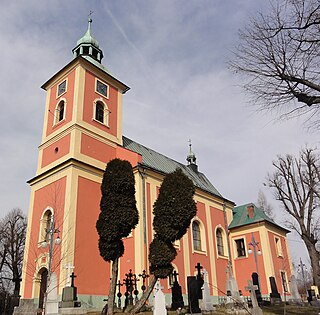
is a village in Gmina Zebrzydowice, Cieszyn County, Silesian Voivodeship, southern Poland, near the border with the Czech Republic. It lies in the historical region of Cieszyn Silesia, on the Piotrówka River.

Cisownica is a village in Gmina Goleszów, Cieszyn County, Silesian Voivodeship, southern Poland, close to the border with the Czech Republic. In 2008 it had a population of 1,705. It lies in the historical region of Cieszyn Silesia on the slopes of Mała Czantoria mountain.

is a village in Gmina Goleszów, Cieszyn County, Silesian Voivodeship, in southern Poland, on the border with the Czech Republic. It lies in the Silesian Foothills and in the historical region of Cieszyn Silesia.

is a village in Karviná District, Moravian-Silesian Region, Czech Republic. It was a separate municipality but became administratively a part of Bohumín in 1974. It has a population of 2,656 (2022). The village lies in the historical region of Cieszyn Silesia.

is a village in Karviná District, Moravian-Silesian Region, Czech Republic. It was a separate municipality but became administratively a part of Dolní Lutyně in 1975. It lies on the border with Poland, in the historical region of Cieszyn Silesia.

Dzięgielów is a village in Gmina Goleszów, Cieszyn County, Silesian Voivodeship, southern Poland, near the border with the Czech Republic. It lies in the Silesian Foothills and in the historical region of Cieszyn Silesia.

is a village in Frýdek-Místek District, Moravian-Silesian Region, Czech Republic. It was a separate municipality but became administratively a part of Třinec in 1980. It has a population of 3,182. and lies in the historical region of Cieszyn Silesia. Tyrka flows through the village.

Kozakowice is a village in Gmina Goleszów, Cieszyn County, Silesian Voivodeship, southern Poland, close to the border with the Czech Republic. It lies in the Silesian Foothills and in the historical region of Cieszyn Silesia. Traditionally as weel as currently they form two sołectwos: Kozakowice Dolne and Kozakowice Górne.
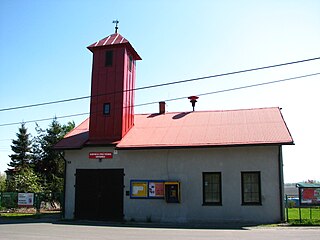
Kostkowice is a village in Gmina Dębowiec, Cieszyn County, Silesian Voivodeship, southern Poland.

Pogórze is a village in Gmina Skoczów, Cieszyn County, Silesian Voivodeship, southern Poland. It lies in the historical region of Cieszyn Silesia.
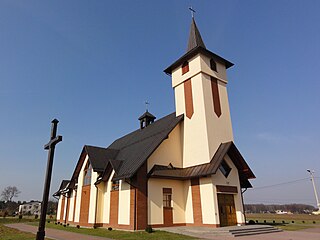
Iłownica is a village in Gmina Jasienica, Bielsko County, Silesian Voivodeship, southern Poland.

Międzyrzecze Dolne is a village in Gmina Jasienica, Bielsko County, Silesian Voivodeship, southern Poland. It lies in the historical region of Cieszyn Silesia.
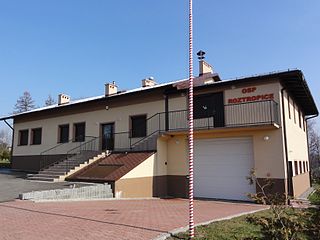
Roztropice is a village in Gmina Jasienica, Bielsko County, Silesian Voivodeship, southern Poland. It lies in the Silesian Foothills and in the historical region of Cieszyn Silesia.

Jasienica is a village and the seat of Gmina Jasienica, Bielsko County, Silesian Voivodeship, southern Poland. It is located in the Silesian Foothills and in the historical region of Cieszyn Silesia.
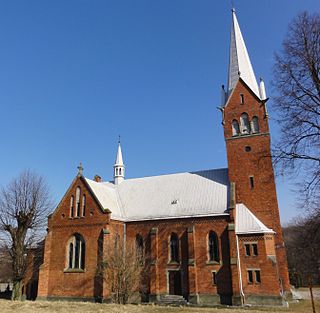
Grodziec is a village in Gmina Jasienica, Bielsko County, Silesian Voivodeship, southern Poland. It lies in the historical region of Cieszyn Silesia.

Mazańcowice is a village in Gmina Jasienica, Bielsko County, Silesian Voivodeship, southern Poland. It lies in the historical region of Cieszyn Silesia.

Radvanice is a part of the city of Ostrava, Moravian-Silesian Region in the Czech Republic. Administratively it is a part of the district of Radvanice a Bartovice. Radvanice was formerly an independent municipality, in 1941 it became a part of Ostrava.

Lipowiec is a district (osiedle) of Ustroń, Silesian Voivodeship, Poland. It was a separate municipality, but became administratively a part of Ustroń on January 1, 1973.

Skalice is a village and administrative part of Frýdek-Místek in the Moravian-Silesian Region of the Czech Republic. It was a separate municipality but became administratively a part of Frýdek-Místek in 1980. It has about 1,400 inhabitants. It lies in the historical region of Cieszyn Silesia.




















